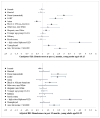Prevalence and Correlates of Youth Homelessness in the United States
- PMID: 29153445
- PMCID: PMC5826721
- DOI: 10.1016/j.jadohealth.2017.10.006
Prevalence and Correlates of Youth Homelessness in the United States
Abstract
Purpose: Unaccompanied youth homelessness is a serious concern. Response, however, has been constrained by the absence of credible data on the size and characteristics of the population and reliable means to track youth homelessness over time. We sought to address these gaps.
Methods: Using a nationally representative phone-based survey (N = 26,161), we solicited household and individual reports on different types of youth homelessness. We collected household reports on adolescents aged 13-17 and young adults aged 18-25, as well as self-reports from young adults aged 18-25. Follow-up interviews with a subsample (n = 150) provided additional information on youth experiences and enabled adjustment for inclusion errors.
Results: Over a 12-month period, approximately 3.0% of households with 13- to 17-year-olds reported explicit youth homelessness (including running away or being asked to leave) and 1.3% reported experiences that solely involved couch surfing, resulting in an overall 4.3% household prevalence of any homelessness, broadly defined. For 18- to 25-year-olds, household prevalence estimates were 5.9% for explicitly reported homelessness, 6.6% for couch surfing only, and 12.5% overall. The 12-month population prevalence estimates, available only for 18- to 25-year-olds, were 5.2%, 4.5%, and 9.7%, respectively. Incidence rates were about half as high as prevalence rates. Prevalence rates were similar across rural and nonrural counties. Higher risk of homelessness was observed among young parents; black, Hispanic, and lesbian, gay, bisexual, or transgender (LGBT) youth; and those who did not complete high school.
Conclusions: The prevalence and incidence of youth homelessness reveal a significant need for prevention and youth-centric systems and services, as well as strategies to address disproportionate risks of certain subpopulations.
Keywords: Adolescence; At-risk youth; Couch surfing; Doubled up; Housing insecurity; Housing instability; Runaway; Unaccompanied.
Copyright © 2017 The Society for Adolescent Health and Medicine. All rights reserved.
Conflict of interest statement
Figures


Comment in
-
Counting All Homeless Youth Today So We May No Longer Need To Tomorrow.J Adolesc Health. 2018 Jan;62(1):1-2. doi: 10.1016/j.jadohealth.2017.10.013. J Adolesc Health. 2018. PMID: 29273139 No abstract available.
References
-
- Medlow S, Klineberg E, Steinbeck K. The health diagnoses of homeless adolescents: A systematic review of the literature. J Adolesc. 2014;37:531–42. - PubMed
-
- Perlman S, Willard J, Herbers JE, et al. Youth homelessness: Prevalence and mental health correlates. J Soc Social Work Res. 2014;5:361–77.
-
- Heerde JA, Hemphill SA, Scholes-Balog KE. Fighting for survival: A systematic review of physically violent behavior perpetrated and experienced by homeless young people. Aggress Violent Behav. 2014;19:50–66.
-
- Greene JM, Ringwalt CL. Pregnancy among three national samples of runaway and homeless youth. J Adolesc Health. 1998;23:370–7. - PubMed
Publication types
MeSH terms
Grants and funding
LinkOut - more resources
Full Text Sources
Other Literature Sources

